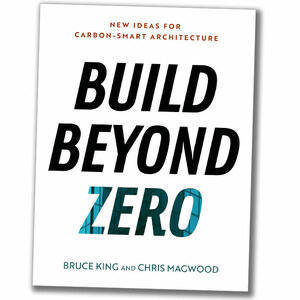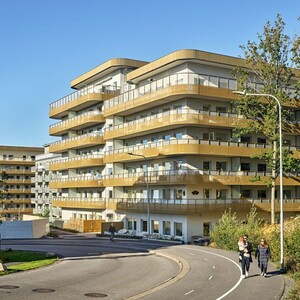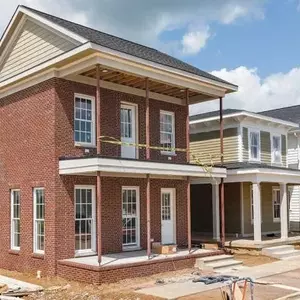
What is “embodied carbon”? I tried to answer that question in a 2018 article called “Carbon Emissions By the Construction Industry.” The issue is complicated, and requires builders to make difficult judgment calls. To learn more about embodied carbon, I attended a presentation by Chris Magwood and Jacob Racusin titled “Beyond Energy Efficiency: Why Embodied Carbon in Materials Matters,” at the “Better Buildings by Design” conference in Burlington, Vermont, in early February.
Chris Magwood is a builder from Ontario who specializes in the design and construction of straw-bale buildings. Jacob Racusin is the co-owner of a residential design-build company in Vermont called New Frameworks Natural Design/Build.
Emissions associated with building material production and delivery
Magwood defined “embodied carbon” this way: “Embodied carbon is carbon that is emitted in the production of materials.” A classic example of this type of emissions would be the carbon dioxide emitted when a gas-fired kiln is used to make bricks. If you know how much carbon dioxide was emitted to make each brick, and how much carbon dioxide was emitted in order to deliver each brick to your job site, you have begun the complicated task of figuring out the “embodied carbon” associated with the brick veneer cladding that you intend to install on your home.
In general, embodied carbon is bad — because if a project’s embodied carbon is high, it means that a lot of carbon dioxide was emitted in order to produce the building materials you’re using. As everyone should know by now, carbon emissions are associated with global climate change.
If you are interested in performing a life-cycle analysis of carbon emissions associated with a building, embodied carbon accounts for only a portion of total carbon emissions. The other type of carbon emissions to consider are those that occur during…
Weekly Newsletter
Get building science and energy efficiency advice, plus special offers, in your inbox.

This article is only available to GBA Prime Members
Sign up for a free trial and get instant access to this article as well as GBA’s complete library of premium articles and construction details.
Start Free TrialAlready a member? Log in















14 Comments
"...if you decide instead that you don’t really need to build a new home after all, the planet will thank you"
That's a good point. I find too often in life, the "do nothing option" is very rarely entertained.
I sometimes wonder if we don't talk about reducing consumption at the aggregate level enough if we genuinely intend on making change. Obviously it would be a contentious issue, but it is something I think is missing from conversations.
Eric,
Dollars are a useful, though imperfect, gauge of environmental damage. Spending less is an excellent way to give the planet some breathing room. If each of us strives to spend less every year, we might make it though the next few decades.
Agreed. In this same line, let's remember that after a certain point, spending money isn't really necessary to be happy. It's almost like this connection between material possessions and happiness is being sold to us or something...
"reducing consumption at the aggregate level"
For sure. And of course the whole being the planet, it get's kinda mind boggling to think on that scale, as far as the system analysis. I think systems analysis is ultimately what we need though. I know it can be a tough sell (especially in America) to look beyond the individual effort, but this article does a nice job alluding to interconnected concepts like energy and transportation grids.
If anyone is interested, Chris Magwood, Jacob Racusin, and Ace McArleton also gave the keynote for NESEA BE19 on this topic ("Carbon Drawdown Now! Turning Buildings into Carbon Sinks"), which is available as video online.
http://nesea.org/buildingenergy-boston-2019-keynote-session
Kohta,
Thanks for the links.
Kohta, thanks for the sharing the video link!
Sorry to high-jack thread...
But does anybody know if all of the segments from this year's NESEA conference were recorded? I looked through the website and could only find the one that Kohta provided above.
I would love to see the one regarding cellulose installations in Maine as well as the mini-split presentation.
Thanks!
I don't think many NESEA sessions were video recorded--mine was not. But most of the presentations have their slides posted--might be more or less useful, depending on the presenter and their style.
Thank you Kohta!
I'll definitely attend next year.
"...the benefits of logging can outweigh the costs in a well-managed forest, but the costs can outweigh the benefits in a poorly managed (or unmanaged) forest."
I think this is a really important piece to this puzzle. I'm curious to learn more about the difference in net carbon sequestration for new growth vs older growth forests. There are carbon releases associated with logging, but I believe new growth sequesters quite thirstily.
"but heat pumps are not great in the New England grid."
Is the NE grid particularly dirty compared to other regions in North America?
Tyler,
You are correct that young forests and old forests have different rates of carbon sequestration. This is a complicated and contentious area of study, and you'll find heated debates on the matter if you start Googling. The answer to most questions on the effects of logging on carbon sequestration is -- no surprise here -- "it depends." Note as well that the forest products industry has a strong economic interest in promoting the idea that logging and sawmills are good for the planet.
In a comment posted below my previous article on this topic, I quoted from the book that was then under review, The New Carbon Architecture:
"...[W]hen it comes to carbon, not all wood is equal: wood may be good, but wood from good forestry is much better. This is true not only when it comes to combating global warming but for myriad other reasons as well.
"In our search for solutions to the climate crisis, we tend to miss the forest for the timber. If your main goal is to sequester carbon, one of the best things we can do with forests is to keep them around and let them grow old. Older forests generally capture and store far more carbon over time than do younger forests. And the oldest forests store the most: what remains of the Pacific coast's original ancient forests are among the greatest carbon sinks on the planet...
"Much is made of the fact that wood stores carbon for the length of its life in a building, ignoring the fact the carbon embodied in wood products accounts for only a fraction of the overall carbon stored in the forest they come from — as little as 18 percent by one estimate. Of the remainder, large amounts may be released to the atmosphere when logging slash rots and soils are exposed by logging. For decades after they occur, clearcuts emit more carbon than regeneration absorbs in spite of the rapid growth rate of young trees. This is because decomposer microbes in the soil work more quickly after a stand is logged, releasing CO2 as they decompose branches, roots, and other organic matter.
"...[C]onventional LCA [life cycle assessment] does not currently address harm that logging may cause to the integrity and diversity of forest ecosystems, to water quality, or to threatened and endangered species.
"Most experts contend that LCA's omissions are not due to any deliberate attempt to deceive, but rather because LCA is the wrong tool for the job — it doesn't have the capacity to reliably measure forest carbon or ecological impacts, much less regulate them."
Here are links to two articles that discuss factors that affect the carbon emissions associated with logging and forestry:
"Tropical forests are a net carbon source based on aboveground measurements of gain and loss"
"The Truth About Industrial Forestry and Carbon Emissions"
These articles, and others like them, need to be balanced by articles that emphasize that responsible forest management can lead to better outcomes than the examples under discussion in the two articles.
I can't recall where but I heard it described like this. Pound for pound, young trees sequester more carbon than old ones. But an acre of old growth forest sequesters far more carbon than an acre of a 20 year old tree plantation. The timber industry likes to focus on the "pound for pound" aspect. But the reality is that old growth forest destruction is a dead end.
Thank you for crafting this post, Martin. Your insights are so helpful.
My mantra? Fossil free and fancy. Take this one to heart, and our blessed land will take you into its heart as well.
I'm finding in my efforts to craft a fossil free home in collaboration with my GC and subs (though they're just doing their thing at the end of the day) that "consumables" - what do y'all call them in the industry? - such as caulk, liquid nails, and the like slide right into the mix effortlessly and raise red flags for me. Not that they're necessarily an issue; however, they may be - and a shift in the dozens or hundreds of bottles and containers of silicone, joint compound, and the like is a relatively low-hanging fruit for builders.
In my project, probably the number one bummer is the Portland-cement concrete, mortar, et cetera that has flooded it. I'm making best efforts to re-institute lime mortar and natural-cement concrete for the longer term; however, zero contractors are around that make natural-cement concrete installations an ancillary service let alone a lead service. Of course, I also now realize that stone and lime mortar (or dry laid) foundations are best on this front.
I see the number ONE opportunity for a sea-change that could happen relatively quickly in the "industry" is the return to stone and natural-cement concrete foundations and the like, thereby eliminating the worldwide dumpster fire heating everything up otherwise known as Portland cement. (Of course, it's all driven by world-scale usury and an assetless-backed monetary system since 1969 maintained by our "leaders" and their bankster masters that increasingly drives us all to distraction, desecration, and destruction - but instead of focusing on the root cause of our Titanic situation we can look at shifts that can be done within the industry in the meantime.)
Thanks again for the stimulating post.
I have been a “sustainable” builder of custom homes and organic farmer for 35+ years – Among other things - I have used washed rock foundations to reduce the use of concrete, I’ve built straw bale homes, I have built SIP homes, and have used reclaimed materials extensively. I am always looking for a way to reduce energy consumption and carbon emissions on the job and in my personal life. My home - an old farmhouse, my farm electrical operations, my construction shop electrical operations, and most of the electricity for my electric car - are zero energy provided by a 13.5 kw solar system.
I try to work toward regenerative processes. This take a much broader lens than one might expect as you partially outline in this article.
Though I have been an advocate of straw bale buildings in general – they do have an impact than one might not expect. In farm operations across the country our techniques have reduced soil organic matter drastically. At about 60% carbon that is a lot of carbon evaporated into the air. Probably the fastest and most promising techniques to sequester carbon and turn around the climate problem is to rebuild the soil. To do this the straw must be left on the ground to help build the ecosystem in the soil and in turn build soil organic matter.
Soil organic matter:
is ultimately the best way to sequester carbon.
it increases the vegetative production above and within the soil.
It increases the water holding capacity of the soil
It increases the nutritional value of the soil thereby producing more nutritious foods with fewer chemicals
It decreases the rate of erosion
Any time we reduce the carbon going back into the soil be it straw or wood – we are reducing the potential to build soil organic matter.
An interesting side note here is that the beef industry has the highest potential and the fastest process for building soil organic matter. Not conventional beef production, but grass feed beef managed by specific grazing techniques and not feed out in a feed lot.
Further I was amazed that “Transport of workers to the job site is the biggest source of emissions. Transportation has a big emission profile. How we get to the job site matters.” That should be easy pickings -I guess we better encouraging carpooling to the job site.
And this – I have used 4’ deep washed rock frost protected foundations successfully several times (a Frank Lloyd Wright technique). This results in a stable home and a huge reduction in the use of concrete. I would love to see research in the area, so codes could be amended for its incorporation.
If we are trying to build low impact projects – we need to be looking at – rammed earth, adobe, earth bag, recycled cellulose insulation, washed rock foundations, and reclaimed materials.
Log in or become a member to post a comment.
Sign up Log in